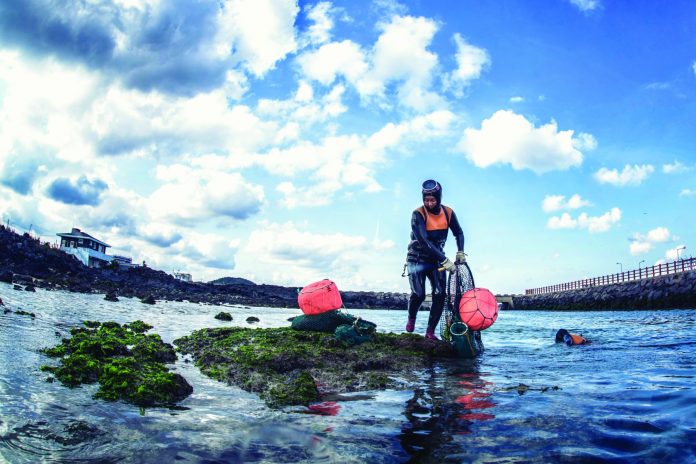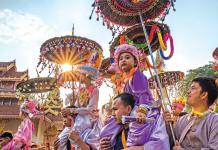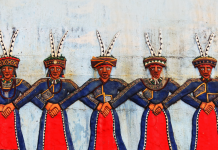The Hae-Nyeo divers of Jeju Island in South Korea have been freediving for hundreds of years, harvesting seafood by hand
Text Oliver Jarvis
Photos Y.Zin Kim
For well over a century, women of the South Korean island province of Jeju – “the Land of Women” – have made their living by freediving – ill-equipped – to the depths of the ocean to harvest seaweed and shellfish. Reaching depths of over 10 metres in chilly waters, and lasting between two to three minutes on a single gulp of air, over 100 times a day, the Hae-Nyeo, or “sea women”, are often seen as myth-like mermaids. For as long as South Koreans can remember, the Hae-Nyeo have dived the waters surrounding Jeju, and have become emblematic of the very characteristics of the society that inhabits the far-flung island, reflecting the independent spirit, iron will and determination of its people.
The semi-matriarchal family structure of the island, where women are the main “breadwinners” of each household, has made Jeju a distant outlier from mainland Korea’s traditionally patriarchal society. As diving is a job reserved for the resident women, and drives the main source of income, they have become the heads of the household. On Jeju and the surrounding islands, men look after the children and care for the family, while the women bring home the money from their diving and farming. This tradition has advanced the status of women on the island, and simultaneously fostered a message of environmental consciousness, promoting sustainable fishing practices.

Today, the Hae-Nyeo are celebrated as one of Jeju’s most valued cultural treasures, and the Korean government shows its appreciation for their unique contributions to Jeju’s culture by subsidising their gear and granting exclusive rights to trade in fresh seafood, which they sell to the small restaurants dotted around the fringes of the island. However, this local diving industry has fallen victim to industrialisation and rising pollution in the surrounding waters.
Traditionally, from the age of 11, when girls of similar ages in other countries would be at school, the island’s girls would begin to train to become Hae-Nyeo. Beginning in the shallows, trainees gradually worked their way up to more challenging depths of over 10 metres. It takes seven years of training almost every day before a girl can be considered a fully qualified Hae-Nyeo, and from that moment she becomes a hardworking “mermaid” for life, spending every day diving under the eye of the early morning sun. In the afternoon, she ventures back to land to farm crops. It’s a lifetime fully dedicated to husbandry, and it is vital to the island’s survival. The women dive daily, through their pregnancies, and even into their mid-90s.

The divers are categorised into three groups depending on their level of experience: hagun, junggun and sanggun. The latter is the most experienced, offering advice and guidance to the younger divers. Before they begin their dive, there’s a prayer for safety and a wealthy catch. The Haesindang Shrine is a holy place where Hae-Nyeo pray to Yeongdeung, the dragon god who controls the sea, and dances such as Jamsugut and Yowanggut are performed as rituals to pray for a good harvest. Previously, the women dived in the freezing waters wearing loose cotton swimsuits called mulot, which consisted of three pieces: mulsojungi (pants), muljeoksam (jacket) and mulsugun (hair tie). They dived for up to two hours at a time.
The women finally began using proper wetsuits, subsidised by the government, in the 1970s. This meant that they could maintain their body heat for longer, and increase time spent in the water. They no longer had to sit by a fire for three to four hours to dry off their cotton clothing before jumping back in. Today, while wearing headlight-shaped scuba masks and lead weights strapped around their waists to help them to sink faster, they still stick to the same techniques to collect seafood. A round flotation device called a tewak, – the size of a basketball – sits at the surface of the water with a net called a mangsari hanging beneath it to collect the divers’ harvest. Sharp tools called bitchangs and kakuri are used to remove abalones, sea urchins, conches and octopuses from the ocean floor.
After a dive, the Hae-Nyeo breach the water’s surface and can be heard whistling – an ancient technique used to expel carbon dioxide from the lungs. Scrambling out of the ocean, tired and breathless, they reveal a human fragility that is imperceptible when they’re gliding underwater. The danger of the job – navigating the line between life and death every day to sustain their families and the island – is manifested in the engraved folds and crease lines on their faces in their later years.

In the 1960s, the Korean government forged a plan to jump-start the country’s economy in every province. Concluding that Jeju was not a practical place to build factories, officials decided to turn it into an exporter of mandarin oranges. By 1969, the majority of rural workers had joined this new industry. About two percent of all land in Jeju was dedicated to farming the fruit, which had a significant impact on the numbers of Hae-Nyeo. Between 1965 and 1970, numbers dropped from over 20,000 to under 15,000, increasing pressure on sustaining the Hae-Nyeo way of life.
UNESCO placed Hae-Nyeo on the Intangible Cultural Heritage list in 2016, but these unique diving traditions are no longer being passed down to the younger generation.
Today, the vast majority of Hae-Nyeo are well into middle age – but against all the odds, the practices of these tenacious divers continue to endure.
For more stories and photographs from this issue, see Asian Geographic Issue 124, 2017




![The Road to Independence: Malaya’s Battle Against Communism [1948-1960]](https://asiangeo.com/wp-content/uploads/2021/07/WhatsApp-Image-2021-07-26-at-11.07.56-AM-218x150.jpeg)






